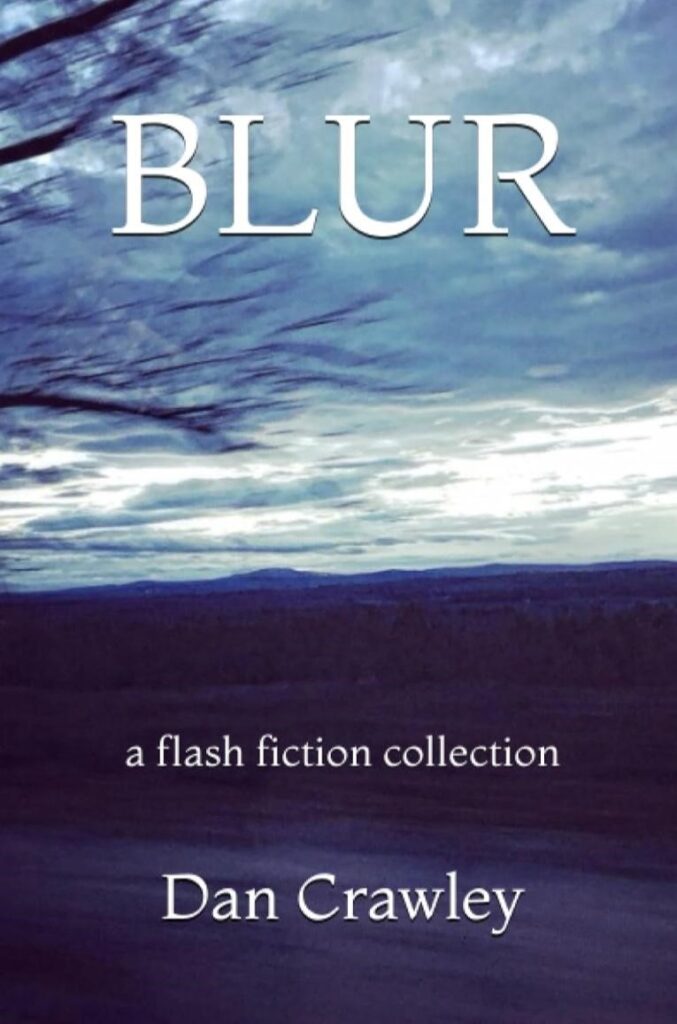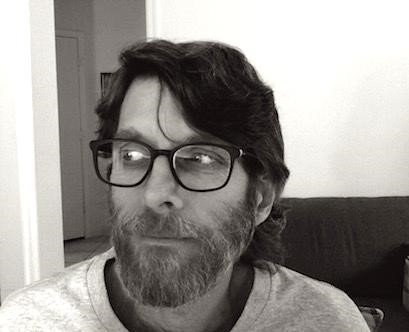By Charlotte Hamrick
Recently, I read Blur written by Dan Crawley and published by Cowboy Jamboree Press. One of the many things I loved about this collection of Flash Fiction is the strong character-driven narratives. Each character has a distinct voice and a distinct story to tell. Whether it’s a Micro of few words or a longer piece, I was fully invested in the who, what, why, where, and how in these works. Dan was kind enough to answer a few questions about the making of his book and his process.

Are the stories in Blur recent ones or do they cover an extended period?
The story “Our Littlest Brother” appeared in Smokelong Quarterly back in 2010, and the most recent stories, “Ran” and “Big Dog,” appeared in New Flash Fiction Review earlier this year. Most of the other flash fictions and micros appeared in journals over the last two years or so. I’m very grateful to all the editors for accepting the different stories in this collection. Their encouragement of my writing helped to keep me going while putting this book together.
Talk about the relationship between personal experience and imagination in your writing.
My own personal experiences and imagination are very intertwined. Many of my stories are autobiographical, to certain degrees. Some of my writing has a small spark of something that happened to me in real life, then the fiction constructs the rest of the story. I think the skewing of reality helps to make the story more interesting craft-wise.
Are there any recurrent themes in your stories? If so, why do you think that is?
I’ve been thinking about those vulnerable and struggling mightily in our world for quite some time. Of course, a lot of my stories have recurrent themes of financial woes, hardships in relationships, parent/child dysfunction. Vulnerability is something that everyone has dealt with at one time or another, so the universality of this theme works to engage a reader.
Though, I do have a few lighter, perhaps happier, stories show up in my thinking now and then. Like “Greetings” in my book. I love this story, and “Educated.” They both made me smile, even as I tangled with them during long revisions.
Strangely, I think happy stories are harder to get right than darker ones. Do you find that to be true in your writing, in general?
Yes! I’m a very character/conflict-driven kind of writer. And even if a happier story has a conflict, it is on the lite side. But I try to have a bit of meat on the bone with the happy story, too. A discord that reveals more about a character.
Which of the characters do you relate to the most and why?
This is a really cool question, Charlotte. I guess a little piece of me is in all my characters. But as I think about it, the particular boy in the Elijah stories is someone I keep coming back to for some reason. Not that the character being raised by a born-again single mother is necessarily me, but I have to admit that the way Elijah reacts sometimes is very relatable. I’m working on new flashes about him and his holy roller mom. And I’m thinking it will be interesting to explore to a greater extent hypocrisy, intolerance, forgiveness, and agape love within this Jesus Movement culture of the 1970s and 80s.
I look forward to reading those! I’m familiar with the Jesus Movement in the 70s with all its emotion and manipulation. Lots of fodder for stories there!
My brother took theology classes when he got his masters at TCU, and told me one time he wrote a paper on the sect we grew up in: neo-pentecostal, or the “charismatic” movement. And yes, everything about the big church we attended in the 70s/80s was messed up. I like the Jesus is Love ideal, but the intolerance, judgments, superiority, and hypocrisy makes me sick to my stomach. And it seems worse today. Plenty of conflicts to get into with my upcoming flashes.
Which story came to you easiest and why do you think that was?
Another awesome question! “Go” came within a day of thinking about this micro. I wrote it fast, having fun going over the structure of how the last bit would play out. I wanted to get into a mind frame of a character not ready to die from an illness that is never explicitly mentioned. Just that feeling of wanting to keep fighting, especially against a body that is giving out, is something that resonates with me.
Yes, “Go” has lots of power in its tiny form and a brilliant last line. I remember reading it online. Micro is a lot like poetry in that it leaves so much to the reader’s imagination. When you write micro, do you worry readers might not get it?
Thanks so much! Yes, I worry all the time about whether my micros are working. I tend toward subtlety. I think readers are smart and can discern a lot. Of course, I know exactly what my aim is for a given story, so I can only hope my clues in such short pieces are doing their jobs.
If you were to write a spin-off about a side character, which would you pick?
I’d like to know what Backslid Jesus, his girlfriend, and his other friends do outside of this church culture. I mean, besides smoking pot and blasting Zeppelin.
“Las Cruces” was one of my favorite stories in the collection. An unexpected scenario occurs and Lea, the main character, takes charge but the ending is as unexpected as the beginning. The buildup was well done. I want to know more about her!
Thanks so much, Charlotte! I’m so glad you dig this story. I enjoyed working on this one. I’m proud of how it moves on the page. It took a lot of revisions to get it right in my mind; I’m glad it worked for you.
Lea is a character that I could explore more, especially after she lands in Tucson with no car, or means to get a life going. I think she’ll be fine, though.
Who are your biggest influences?
Right now it seems to be writers working within the microfiction form. This type of writing fascinates me to no end and is a real challenge for me, in a good way! I’m devouring the writings of Laura Besley, Kim Chinquee, Jonathan Cardew and the like.
What is the most valuable piece of advice you’ve been given about writing?
Raymond Carver quoting from Saint Teresa:
“Words lead to deeds…. They prepare the soul, make it ready, and move it to tenderness.”
Carver, Raymond. “Meditation on a Line from Saint Teresa.” Call If You Need Me: The Uncollected Fiction and Other Prose, Vintage, 2001, pp. 123-125

Dan Crawley
Dan Crawley is the author of Straight Down the Road (Ad Hoc Fiction, 2019), The Wind, It Swirls (Cowboy Jamboree Press, 2021) and Blur (Cowboy Jamboree Press, 2023). His writing appears in numerous literary journals, including Wigleaf, JMWW, Best Small Fictions, Atticus Review and Smokelong Quarterly.

Charlotte Hamrick
Charlotte Hamrick’s creative writing and photography has been published in a number of literary journals and anthologies including Still: The Journal, The Citron Review, Atticus Review, Reckon Review, Trampset, and New World Writing, among many others. Her fiction was selected for the Best Small Fictions 2022 and 2023 anthologies and she’s had several literary nominations including the Pushcart Prize, Best of the Net, Best Small Fictions, and Best Microfiction. She is the former Creative Nonfiction Editor for Barren Magazine and current Creative Nonfiction Editor for The Citron Review. She also writes intermittently on her Substack, The Hidden Hour. She lives in New Orleans with her husband and a menagerie of rescued pets where she sometimes does things other than read and write.
